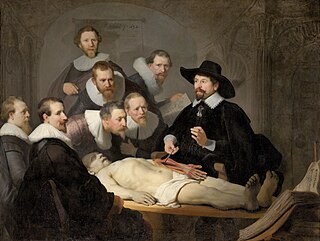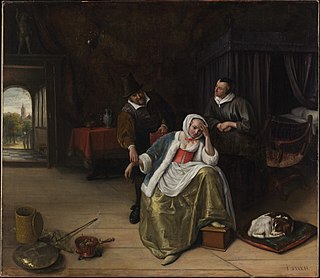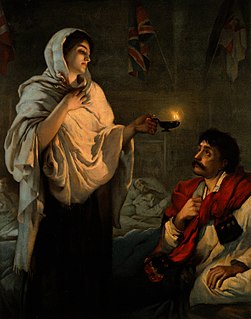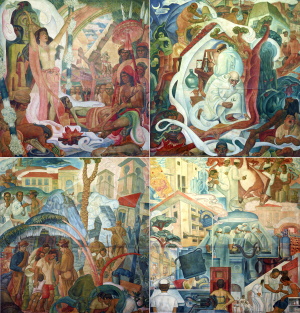 W
WThe Agnew Clinic is an 1889 oil painting by American artist Thomas Eakins. It was commissioned to honor anatomist and surgeon David Hayes Agnew, on his retirement from teaching at the University of Pennsylvania.
 W
WThe Anatomy Lesson of Dr. Deijman is an 1656 fragmentary painting by Rembrandt, now in Amsterdam Museum. It is a group portrait showing a brain dissection by Dr. Jan Deijman (1619–1666). Much of the canvas was destroyed in a fire in 1723 and the painting was subsequently recut to its present dimensions, though a preparatory sketch shows the full group.
 W
WThe Anatomy Lesson of Dr. Nicolaes Tulp is a 1632 oil painting on canvas by Rembrandt housed in the Mauritshuis museum in The Hague, the Netherlands. The painting is regarded as one of Rembrandt's early masterpieces.
 W
WBonaparte Visits the Plague Stricken in Jaffa is an 1804 painting commissioned by Napoleon Bonaparte by Antoine-Jean Gros to portray an event during the Egyptian Campaign. The scene shows Napoleon during a striking scene which is supposed to have occurred in Jaffa on 11 March 1799, depicting then General Bonaparte making a visit to his sick soldiers at the Armenian Saint Nicholas Monastery. The commission was an attempt to embroider Bonaparte's mythology and quell reports that Napoleon had ordered fifty plague victims in Jaffa be given fatal doses of opium during his retreat from his Syrian expedition.
 W
WChesham Street is a 1910 oil on canvas painting by Australian artist George Washington Lambert. The work depicts a doctor performing an auscultation on a man with his shirt lifted and torso exposed. The work was painted at the Rossetti Studios on Flood Street in London. The painting is one of a set of "puzzle pictures" painted by Lambert between 1910 and 1914. These paintings are said to "appear to have a meaning and yet are not strictly narrative; they invite the viewer to provide their own interpretation.".The man sits boldly in front of the viewer, holding up his shirt and revealing his entire torso. His head is held high, his lips are closed and he looks down at the viewer, seeming somewhat superior. His pale flesh, with the play of light on it, gleams against the dark surroundings.
 W
WA Clinical Lesson at the Salpêtrière is an 1887 group tableau portrait painted by the history and genre artist André Brouillet (1857–1914). The painting, one of the best-known in the history of medicine, shows the neurologist Jean-Martin Charcot giving a clinical demonstration to a group of postgraduate students. Many of his students are identifiable; one is Georges Gilles de la Tourette, the physician who described Tourette syndrome.
 W
WThe Doctor is an 1891 painting by Luke Fildes that depicts a Victorian doctor observing the critical stage in a child's illness while the parents gaze on helplessly from the periphery. It has been used to portray the values of the ideal physician and the inadequacies of the medical profession. Different theories exist as to the painting's origin but it is most likely based upon Fildes' own experience of the death of his son. Critics have noted that Fildes omitted common medical equipment of his era in order to focus on the relationship between physician and patient.
 W
WThe 'Finger-Assisted' Nephrectomy of Professor Nadey Hakim and the World Presidents of the International College of Surgeons in Chicago, or, The Wise in Examination of the Torn Contemporary State is a painting by British artist Henry Ward depicting transplant surgeon Nadey Hakim demonstrating the removal of a living donor kidney. It is on display at Başkent University, Ankara, Turkey.
 W
WThe Gross Clinic or The Clinic of Dr. Gross is an 1875 painting by American artist Thomas Eakins. It is oil on canvas and measures 8 feet (240 cm) by 6.5 feet (200 cm).
 W
WHomeopathy Looks at the Horrors of Allopathy is an allegorical painting by Russian artist Alexander Beideman, painted in 1857. It is owned by the Tretyakov Gallery in Moscow, Russia. The picture measures 65.5 × 77.3 cm. and has the accession number 1795. In the 19th century, the painting was also known as Triumph of Homeopathy.
 W
WThe Lovesick Maiden is a c. 1660 genre painting by Jan Steen. It shows a young woman suffering from love-sickness surrounded by her doctor and a maid-servant. It is in the collection of the Metropolitan Museum of Art.
 W
WThe Inspection is the third canvas in the series of six satirical paintings known as Marriage à-la-mode painted by William Hogarth.
 W
WMiss Nightingale at Scutari, 1854, also known as The Lady with the Lamp, is an 1891 painting by Henrietta Rae. It depicts Florence Nightingale at Scutari Hospital during the Crimean War.
 W
WThe Progress of Medicine in the Philippines is a painting by Filipino artist Botong Francisco. It was commissioned in 1953 to depict the history of Philippine medicine. It is currently on display in the National Museum of Fine Arts in Manila.
 W
WThe Quack Doctor is a panel painting by the Dutch artist Gerrit Dou from 1652. It depicts a crowd gathered around a quack doctor as he promotes his wares. Dou also paints himself leaning out the window with a palette in hand. By including himself in the composition, he contrasts the deceptions involved in painting with those of quack medicine. For Dou, the composition was a departure; he was known for niche pieces, which depict an interior framed by a window. The painting has been written about quite extensively and is among the best-known treatments of its subject.
 W
WSaint Sebastian Tended by Saint Irene is an incident in the legends of Saint Sebastian and Saint Irene of Rome. It was not prominent in the hagiographical literature until the late Renaissance, and is hardly seen in art before then. As an artistic subject, normally in painting, it suddenly became popular from the 1610s, though found in predella scenes as early as the 15th century, and was most popular until about the 1670s.
 W
WScience and Charity is an oil on canvas painting by Pablo Picasso, which he painted in Barcelona in 1897. It is an example of one of Picasso's earliest works, as he painted it when he was only 15 years old. The painting depicts a formal composition of a sick patient in bed, attended by a doctor and a nun holding a child. It was the culmination of Picasso's academic training and displays his talent as an artist before he moved away from this style to pursue his own artistic career. The painting is housed in the collection of the Museu Picasso, Barcelona.
 W
WSelf-Portrait with Dr Arrieta is the English title given to a painting by Spanish artist Francisco Goya. The work is an oil on canvas, painted in 1820, and is currently held in the Minneapolis Institute of Art, Minnesota. Many scholars have seen religious themes in the work. Other interpretations compare and contrast the painting with Goya's series of Black Paintings, contextualizing the work within his career at large.
 W
WThe Surgeon or The Village Surgeon is a c.1550-1555 oil on panel painting by Jan Sanders van Hemessen. It was first catalogued in 1614 in the Spanish royal collection at the El Pardo Palace. It is now in the Prado Museum in Madrid. It shows a barber surgeon carrying out a trepanation.